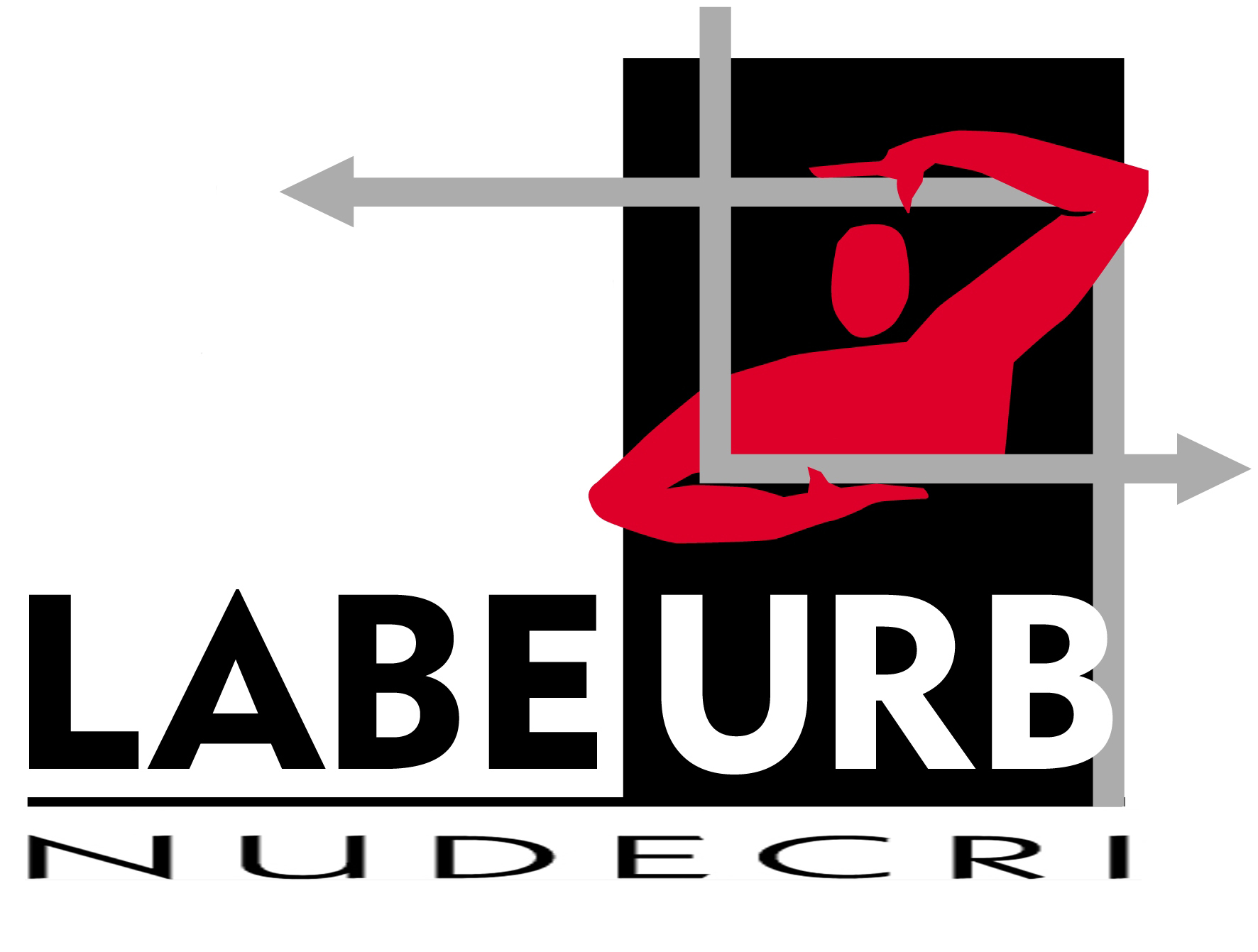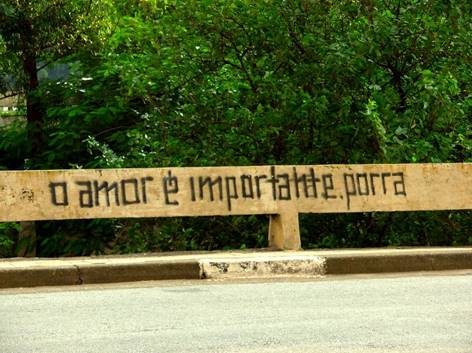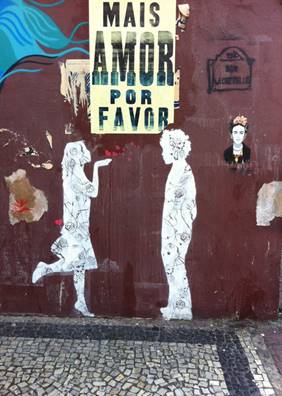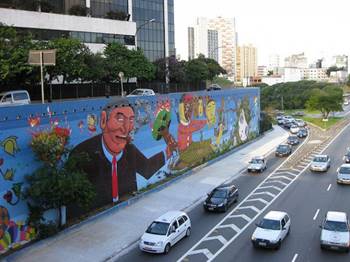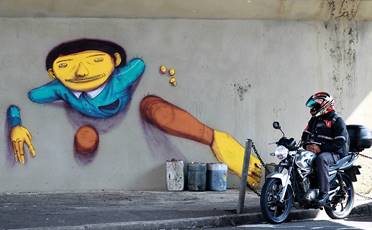Graffiti, affective inscriptions and new expressions of visibilities in São Paulo’s urban landscape.


Tatiana Amendola Sanches
Tarcisio Torres Silva
Introduction
Graffiti and tagging are common themes in contemporary Cultural Studies, especially due to the sociopolitical roles they perform. It can be noticed, however, that new forms of Street Art manifestations have been emerging recently, and whose themes go beyond political denouncement.
The Brazilian city of São Paulo has a population of 11 million people and is the largest city in South America. It is a very interesting place to observe this phenomenon, since the city grew in a restless and disorganized way, favoring the practice of Street Art manifestations. In 1920, its population was less than 500,000 people, which generated over the years many densely populated neighborhoods, whereas other spaces - like the central ones - are nowadays suffering from abandonment. These quick transformations of urban landscape create degenerated spaces. Such changes also resulted in the proliferation of viaducts and other public transportation solutions for cars and buses that are the main systems in town (yet completely saturated).
Besides these factors, the city has been regulated under the Law “Cidade Limpa”, or “Clean City”, which forbids advertisement on billboards and standardizes the size of signs for the business establishments on the streets. This municipal action provoked a drastic decrease on visual pollution and made room for Street Art to become more remarkable. Although Cidade Limpa’s effects are positive, Street Art is sometimes mistaken by loitering and it is eventually erased from the city’s walls.
Regarding the recent Street Art movements in the city, we outline “Mais Amor, Por Favor”[1] (“More Love, Please”) or “O amor é importante, porra”[2] (“Love is important, damn it!”). Such inscriptions have become more and more visible on the city’s walls, creating echoes, dialogues and appropriations. Taggers and graffiti artists claim for love drawing melancholic images which inspire thoughts about the finitude of time, good and evil, love and hate. Reproductions and appropriations inspired by artists like Banksy proliferate, pleading for a war of flowers and hope, in places where the latter seems to escape from.
These sentences and drawings are diffused by a vast array of techniques, especially through graffiti, which diffuses a positive atmosphere through the entire city. As Andrea Brighenti states, the definition of this technique is not simple, for it is difficult to draw its frontiers:
Graffiti writing is a field whose definition is problematic for a number of reasons… it is difficult to identify its boundaries. Writing interacts and often overlaps and interweaves with the fields of other practices … including art and design (as aesthetic work), criminal law (as vandalism crime), politics (as a message of resistance and liberation), and market (as merchandisable product) (BRIGHENTI, 2010, p.316).
In Brazil, the term grafite (grafitti) is used to distinguish its practice from the one of pixação (tagging). Overall, graffiti works are linked to “artistic” and “political” purposes, according to Brighenti’s terms. These works are recognized by their visual-aesthetic powers and the positive impact they cause on the landscape. It is therefore a technique usually more accepted by the city powers, and it is allowed in designated public spaces. In this essay, we understand “grafitti” under such parameters.
As we can notice in the figures bellow, inscriptions and designs color grey walls with affective messages and humanized characters. Figure 1 can be classified as tagging, whereas Figure 2 is a mix of collage (a technique locally called ‘lambe-lambe’) and graffiti.
Figure 1. Love is important, damn it!
Available at: <http://www.panoramio.com/photo/21349934>.
Accessed on May 25, 2015.
Figure 2. More love please
Available at: <http://factoide.com.br/wp-content/uploads/mais-amor-por-favor-general-osorio.jpg>. Accessed on May 25, 2015.
This movement has also fostered public manifestations in São Paulo, such as the demonstration that took place at the Roosevelt Plaza in October 2012, for the participation of the act called “Existe Amor em São Paulo” (“There is Love in São Paulo”) - with the attendance of about 10,000 people (Viana, 2013). This manifestation was organized by Circuito Fora do Eixo (Circuit Out of the Axis), a network of cultural organizers which has become known for recording the rallies performed in the country in June 2013.
At that time, São Paulo hosted demonstrations against the raise on bus tickets’ fares. The first marches were organized by Movimento Passe Livre (“Free Pass Movement”), and gathered 60,000 people. When these marches spreaded throughout the country, the protesters added other demands to the main cause, such as questionings regarding the expenses of the 2014 World Cup, corruption, Police violence, among others. Many marches incorporated the action of the “black blocks”, internationally recognized as groups that depredate public buildings and business establishments. The protests’ intensity, along with the policemen reaction toward it caused the theme to become the center of debates in the media during most of the 2013’s second semester in the country.
Noticeably, there is a political reason intrinsic to the movement “There is Love in São Paulo”, which is yet to be better explored. This is not necessarily a moment that has merely emerged in the country; on the contrary, there were networks planning and articulating the promotion and election of themes, in order to manage their diffusion through numerous collaborators. Once inserted on the melting pot, the movement started gaining other shapes, until it was inevitably absorbed by discourses in media, since the language proposed by the movement was some sort of politicization of the non-political, the private life, and the citizens’ emotional burdens. These issues, in turn, are easily assimilated by other types of discourses.
One can therefore note that leftwing movements did not see this love aesthetization favorably, as an act of political expression, since one can relativize the real intention of its effects. Compared to the June 2013 manifestations, the movement “There is Love in São Paulo” generated mobilizations that did not cause any kind of direct affront to the public power. This means - under a more radical view – that there is no perspective for change. On the contrary, the movement would contribute with status quo manifestations, and with the permanence of good relations between cultural agents and the public power. Viana explains that:
The peaceful manifestations were shown and celebrated because they allowed São Paulo to keep on working. More than that, they created a dissenting appearence, which simultaneously contributed to the diversification of cultural merchandise and the consumption niches – yet eventually causing nuisance, such as the high pitch sound right on a restful Sunday. (VIANA, 2013, p.56-57)
Considering this perspective and pondering over the several political instances that pervade the patent cultural production of this movement, we would like to proceed with our argumentation, now focusing on the emotional aspects of this production.
We stand by this position because we understand that - regardless the political forces, which promote the politicization (or the non-politicization) of the urban space - the aesthetic elements used on graffiti collaborate with a change over the city’s view. It is actually a language that flirts with other cultural fields: more favorable to the market and easily absorbed by it. We shall remember, however, that this irony had already been preached by Pop Art and continues to be explored by Banksy and other street artists.
Our current experience is of a cultural moment in which everything can be easily reformulated and serve to a vast array of interests. It is precisely this irony that dialogues with the city’s humor; and this is also our interest in this paper, because when the figures of mass culture and other signs are mixed with advertisement, the language brought by these artistic movements can promote fissures on the passerby’s view, promoting transformations in his or her relationship with the city and the urban space.
Therapeutic Culture and Structures of Feeling
In case of the contemporary movements here analyzed, we observe a displacement of traditional public and private instances, causing the great urban centers to become visibility stages of its inhabitants’ feelings. Besides this, the affective writings - those who aim to express feelings – seem to be in sync with the construction of the idea of a Therapeutic Culture (Furedy, 2004; Illouz, 2011a, 2011b), which allows the subjects to name feelings, make them visible, and therefore, liable to a reflexive experience while they simultaneously reveal a reconfiguration of problems that used to be seen as political and economical, but are currently understood as psychological ones. Illouz (2011b) understands affective writings as it follows:
Writing a feeling is to ‘lock it’ on space, in the sense that it creates a distance between the feeling experience and the conscience that the person has about it. (...) The reflexive act of naming affections, in order to handle them, grants them an ontology, fixing them on the reality and the deep self of its holders. This fact, shall we say, counters the volatile, transitory and contextual nature of affections. (ILLOUZ, 2011b, p.51)
If the city’s walls have already served as visibility stages for socioeconomic manifestations in large urban centers in a recent past, nowadays these walls seem to build a post-modern Wailing Wall, which can be understood as Structures of Feeling (Williams 1989). The author perceived artworks and literature as subjective expressions arising out of life’s objective character.The concept sounds particularly strange because it gathers two apparently distant words: structures and feeling.
For Paul Filmer (2003), the concept transmits a preliminary level of consciousness, which is yet a feeling. In other words, from this perspective, Street Art is the outcome of feelings from the artist who created the graffiti. However, it bears more than the subjective expression of life: it covers impressions, which are yet not very evident of life’s objective character, but represent the social structures surrounding artists.
On one hand, we can understand graffiti within the word structure, which refers to something fixed. On the other hand, we can understand it as feeling, which refers to agency, something more flexible. This apparent contradiction is key to think culture in the present world, since the cultural sphere is not only formed by institutions that can be conceived as structures in Marxist terms, but also through communication practices that are symbolic and cross over both the feelings and the subjectivity construction of contemporary subjects.
Although the concept’s creation is attributed to Williams as a methodology of literary works analysis, it is frequently used to reflect upon Communications (Best, 2012) as an open field in constant transformation. Thus, it can be applicable to other cultural forms in progress.
When Beverly Best (2012, p.192) analyzes the phenomenon of reality TV, he states that “cultural innovation is formulated as the mediation of structure and agency, the mediation of acting with intent on the social world and the social world that informs all intentions and practice”. For Best, the concept refers to the precarious balance among structural forces, social processes and the subjects’ interests:
“Structure of feeling” expresses the contradiction that our personal, intimate, individual experiences (feelings) are always, at the same time, informed by collective and historical prejudices, expectations, fears, desires, conventions, institutions, laws, and modalities of the social that transgress even the most extended view of the feeling subject. Structure of feeling connotes the sense that the feelings that belong to us, that animate us as individuals, at the same time, exceed us, extend far beyond the individual, diachronically and synchronically. (BEST, 2012, p.194)
As quoted above, the individual experiences are seen as collective experiences. In this train of thought, although graffiti seems more and more based on individuals and their desires for self expression and recognition, it is also the expression of a desire for social transformation, yet manifested on preliminary level ou consciouness.
São Paulo: Grey City
Underneath a grey city, there is love for our city.
Os Gemeos
If graffiti, tags, posters and other kinds of St reet Art have been serving to reveal affections that pervade the contemporary world, how is this specifically happening in São Paulo?
Although we can find connections among the variety of graffiti produced around the world, in huge South American cities like São Paulo, affective inscriptions are related to the city’s critical issues, like violence, social differences and traffic jam (which ironically allows people to have more time for a glimpse on Street Art works).
Whilst these works contribute to a transformation of the urban landscape and to the international recognition of some graffiti artists, they still struggle to legitimize this kind of art on the city’s street. While there are addresses in which panels are huge, preserved and familiar to passersby in some areas, there are still less noticeable street spaces, in which the act of making graffiti may cause conflicts.
An example of this tension between public power and street artists is the documentary “Cidade Cinza” (“Grey City”), directed by Marcelo Mesquita and Guilherme Valiengo, launched in 2013. The film shows some dilemmas faced by graffiti artists in their attempts of expressing their feelings in the greyish structure of São Paulo. The narrative is built around a wall of more than 700 meters in 23 de Maio Avenue in midtown, which was erased by the São Paulo’s city government in 2008, as part of the urban cleaning policy that was ruling at that time. The case went public, which caused the city government to retreat on its position and to release the space again to graffiti artists, who were sponsored this time. In this new endeavor, important artists took part, like Nunca, Nina and the twin brothers Gustavo and Otávio Pandolfo, best known as Os gemeos[3] or “The Twins”.
Figure 3. The new panel painted by the artists at 23 de Maio Avenue
Available at: http://www.proximofuturo.gulbenkian.pt/sites/default/files/ficheiros/os_gemeos_by_jack_two.jpg>. Accessed on May 25, 2015.
About the practice of installing graffitis in the city and the intentions surrounded by it, the brothers say in the film:
São Paulo is a concrete jungle, man. Building, building, building, building. The more is built, the less trees, parks, more building, building, building. It kinda builds a wall around it. You must escape, somehow you have to run away from this or to be part of this, which is the History of Graffitti, you know.
Os gemeos also have another recent case, occurred in 2013, when the duo worked on a graffiti in São Paulo’s midtown. The initial workpiece showed a figure that represented a graffiti artist and contained the following sayings: “Year comes... year goes... and there’s nothing new!!!” Soon after, the work was erased by the city government’s workers. The brothers then returned to the same place and worked again, this time leaving a message to the city mayor, right beside a figure which resembled the previous one: “Mr. Mayor, this city has many serious problems that urge for results! Do not waste your time and $ erasing graffiti on the streets!” The work was again erased, and the brothers returned a third time to the site and left the saying: “Mr. Mayor, erasing art is erasing culture; erasing culture is disrespecting people”. [4]
As expected, the direct defiance was also erased. Os gemeos acted again; this time, instead of expressing their feelings through the city government through words, they decided to create a panel without words. They painted a character as if he was coming out of the back of a grey wall (Figure 4). This time, because there were no direct messages against the public power, the work was preserved. The same idea was about to be repeated through other places in the city, and paired with the phrase: “Underneath a grey wall, there is love for our city”.
Figure 4. The last polemical graffiti about the wall.
Available at: <http://f.i.uol.com.br/fotografia/2013/05/10/275197-970x600-1.jpeg>.
Accessed on May 25, 2015.
This way, the case brings up the pacific movement of love for the city. It shows the dialog of the graffiti artists with other works that intend to enhance the degree of affectiveness among Sao Paulo’s citizens. The final work of the man who beats the grey wall might be representing the street artists’ class, just as much the citizen, who wishes to see a landscape beyond the grey colored walls. It is a melancholic figure, but at the same time, a colorful one, typical on the works of Os gemeos.
This counterpoint between the colorful, happy and harmonic figures and the restless, messy, dirty and at times dangerous city’s landscape is very appealing to the eyes. In the apparent naïveté of the represented characters, we observe a gap isolating the scenario from its surroundings, and yet paradoxically, they communicate a sense of closeness to the passersby.
One likely interpretation for this condition - that pervades the citizen’s view of these works - is the one present on Jacques Rancière (2012). The author argues that during the artwork construction, the gathering of heterogeneous art elements may cause shocks. Such shocks would have the function of evidencing the conflicts that are part of History’s flux. The author mentions the montage technique used by artists who use contrast in their artworks. Some examples can be found in the movies (in this case, the author emphasizes Godard’s work); the practice can also be found in other fields of art, such as literature and plastic arts.
When approaching the political sense on Godard’s work, Rancière says that “all connections of contradictory elements could go through a critical “detour” of the prevailing logic, and that all the sequence of nonsense could go through a “situational” “drift”. (Rancière, 2012, p.71). In this sense, the imagetic elements used in Graffiti can benefit from the art’s materiality, which quarrels over spaces with the very own signs of a big city. Signs, buildings, viaducts, cables and bus stops. The paint and the manual production, like the isolation of elements on the city’s walls, dislocate the practice of graffiti artists from the works producted by art schools.
The montage that causes shock, as presented by Rancière, can be understood from the point of view of graffiti because of the disparate elements that this type of art gathers in a metropolis like São Paulo. Colorful elements that promote harmony, love and happiness clash with the city’s reality, causing nuisance on the viewer.
The use of pop culture elements (cartoon characters and other internationally well known images) – a recurrent practice on Banksy’s works – also aids on the task of being appealing to the eyes in forgotten and inhospitable places of urban landscape. On can therefore conceive that the shock effect can be created through the junction of this art’s elements, which are developed around its materiality, the place’s symbolic choice and the plasticity of the represented elements.
Understanding “montage” on graffiti this way, we can infer that São Paulo’s scenario collaborates with the capture of the citizen’s view, so that these affective inscriptions can talk about love. As Rancière well observes, the “interruptions, derivations and rearticulations that modify the images’ circulation less pompously do not have a sanctuary. They happen everywhere and at anytime.” (Rancière 2012, p.38).
Deconstructing the Blasé view
Georg Simmel’s classic text about the mental life in a metropolis dates from 1903, but it still dialogues with the testimonies of the documentary “Grey City” (mentioned above) shoot 110 years later. In several moments, it seems that Os gemeos’ intent is overly related with Simmel’s text publication, in spite of the temporal hiatus between them. Simmel’s first lines in the text show us some parallels:
The deepest problems of modern life flow from the attempt of the individual to maintain the independence and individuality of his existence against the sovereign powers of society, against the weight of the historical heritage and the external culture and technique of life. (SIMMEL, 1972, p.325)
At the very start of “Grey City”, the brothers say they believe that São Paulo – the city where they grew up – does not seem to be made for people, insinuating that it is an objective city, made for machines. On the film’s first part, it is clear that these artists have a specific goal: to be recognized as individuals within the grey anonymity of the big city. Os gemeos also say that they do not want to see the grey; they want to see their name in the city. There is always, like on Simmel’s text, a certain resentment with the life on the metropolis, which is treated as something negative, something that nullifies the subject, turning him or her into an object. The artists’ manifest desire is to interrupt and subvert this, since the graffiti is seen as a subjective expression.
For Simmel, the Blasé view would be the mental answer of the life in the metropolis. In other words, the inability of reacting to new stimuli (the blasé attitude) would result from a strong nerve stimulus experienced in great metropolis. Os gemeos say that graffiti is the precise attempt to bring attention back to people, make them look where they usually do not: “The guy is writing there because he needs to say something, to get something out of his chest”. While Simmel outlines the objective character’s prevalence, the outcries for more love in the grey city still aim at reversing this diagnostic.
But for Nunca, another graffiti artist on the film, what appealed to him on the graffiti world was to do something that people could see and recognize. He states that:
This is the most direct form to deal with every person as a human being. We do not see each and every car that comes by as a machine, you know, I think every car is a story. The guy who argued with his wife, a girl who fell in love, you know? Everybody has a story here. It is people, human beings. I think everything here is a way to dialogue with these people, you know? Graffiti gives that shock; one day a guy sees this all grey, and on the other day it is all colored. This is cool.
In the beginning of this essay, we observed that the kind of graffiti that clamors for love is much criticized for supposedly having abandoned the political character. In this sense, and aligned with Furedy’s analysis (2004), graffiti was maybe thought as part of the emotionalism culture, in which social problems are seen as deriving from our inner selves. To the extent that the artists above aim at the desire of their subjective expression, of seeing their name written and dealing with each inhabitant of the metropolis as an owner of a unique story, we can recognize here a desire for expression of a certain individualism, or the inner life. According to the author, this emotionalism culture leads to a self that he names ‘asocial’. It is a self who is not concerned with the collectivity, resulting from the perception of a flaw on the social institutions that affect the individuals’ emotions:
Ideas, emotions and passions expressed to an intimateate soul mate become something different when disclosed to a public audience (...). Ironically, the devaluation of the private sphere does not mean a commitment to the positive development of the public one. The demonstration of the private sphere goes hand in hand with the decline of an ethos of public responsibility. The attitude of therapeutic culture towards the private and public sphere is a contradictory one. (FUREDY, 2004, p.72)

